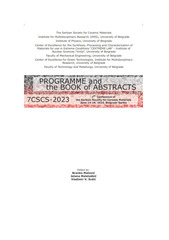Приказ основних података о документу
ZnMn2O4 as a Cathode Material in an Aqueous Solution of ZnCl2 and Mn(NO3)2 for Zn-ion Batteries
| dc.creator | Nikolić, Nenad | |
| dc.creator | Senćanski, Jelena | |
| dc.creator | Blagojević, Stevan | |
| dc.creator | Pagnacco, Maja | |
| dc.creator | Stojković Simatović, Ivana | |
| dc.date.accessioned | 2023-12-03T13:47:29Z | |
| dc.date.accessioned | 2024-01-10T14:11:04Z | |
| dc.date.available | 2023-12-03T13:47:29Z | |
| dc.date.available | 2024-01-10T14:11:04Z | |
| dc.date.issued | 2023 | |
| dc.identifier.isbn | 978-86-80109-24-4 | |
| dc.identifier.uri | https://cer.ihtm.bg.ac.rs/handle/123456789/6966 | |
| dc.identifier.uri | https://riofh.iofh.bg.ac.rs/handle/123456789/1054 | |
| dc.description.abstract | Due to Li-ion batteries having become the main power source of most portable electronic devices, their waste has also become a significant environmental problem. To find batteries that would be environmentally friendly, this work examines Zn-ion batteries in an aqueous solution of ZnCl2. The ZnMnO4 was synthesized by glycine nitrate combustion of Zn(NO3)2, Mn(NO3)2 and glycine as a chelating agent [1]. The structure of the material obtained was characterized by X-ray powder diffraction (XRPD) showing a spinel structure; the morphology was characterized by scanningelectron microscopy (SEM) showing that nano-particles were obtained. The electrochemical characterization was done by cyclic voltammetry in an aqueous solution of ZnCl2. The mixture pasted on the glossy carbon electrode was prepared by mixing the cathode material, graphite and polyvinyl diene difluoride (PVDF) in a ratio 85:10:5 [2]. Due to the low discharge capacity obtained of ~14 mAh g-1 for 5 mV s-1 , further examination was done by adding 1 ml of 1M Mn(NO3)2 into 10ml of a saturated aqueous solution of ZnCl2. After adding the Mn(NO3)2 , the dischargecapacity increased from ~14 mAh g-1 to ~65 mAh g-1 at the same polarization rate, making this additive a promising one for aqueous Zn-ion batteries. Further investigation needs to be directed to adding the same additive in larger amounts compared to 1ml to the same volume of the electrolyte. The results obtained suggest the aqueous Zn-ion battery described in this work to be a potentially promising “green” battery that may replace harmful commercial organic Li-ion batteries. | sr |
| dc.language.iso | en | sr |
| dc.publisher | Institut za multidisciplinarna istraživanja | sr |
| dc.rights | openAccess | sr |
| dc.rights.uri | https://creativecommons.org/licenses/by-nc-nd/4.0/ | |
| dc.source | Programme and book of abstracts - 7th Conference of the Serbian Society for Ceramic Materials, 7CSCS-2023, June 14-16. 2023, Belgrade, Serbia | sr |
| dc.subject | Zn-ion batteries | sr |
| dc.subject | batteries | sr |
| dc.title | ZnMn2O4 as a Cathode Material in an Aqueous Solution of ZnCl2 and Mn(NO3)2 for Zn-ion Batteries | sr |
| dc.type | conferenceObject | sr |
| dc.rights.license | BY-NC-ND | sr |
| dc.citation.epage | 103 | |
| dc.citation.spage | 103 | |
| dc.identifier.fulltext | http://riofh.iofh.bg.ac.rs/bitstream/id/1663/Abstract-book-2023-zn.pdf | |
| dc.identifier.rcub | https://hdl.handle.net/21.15107/rcub_cer_6966 | |
| dc.type.version | publishedVersion | sr |

